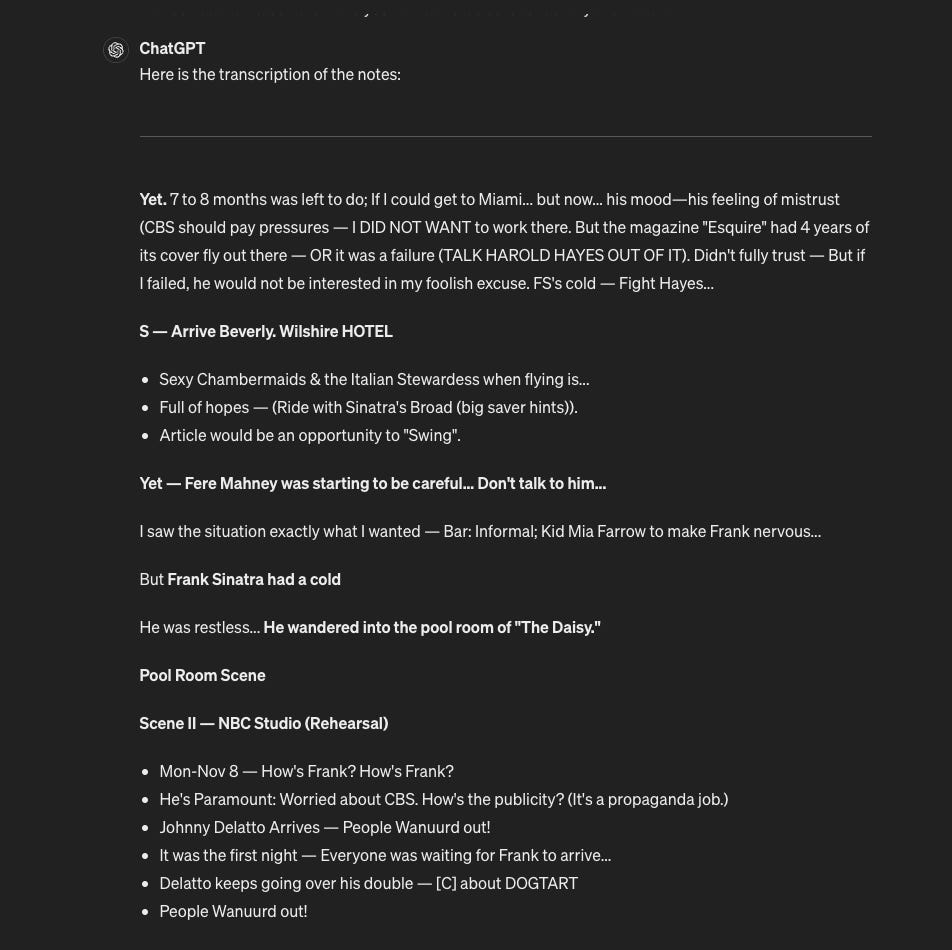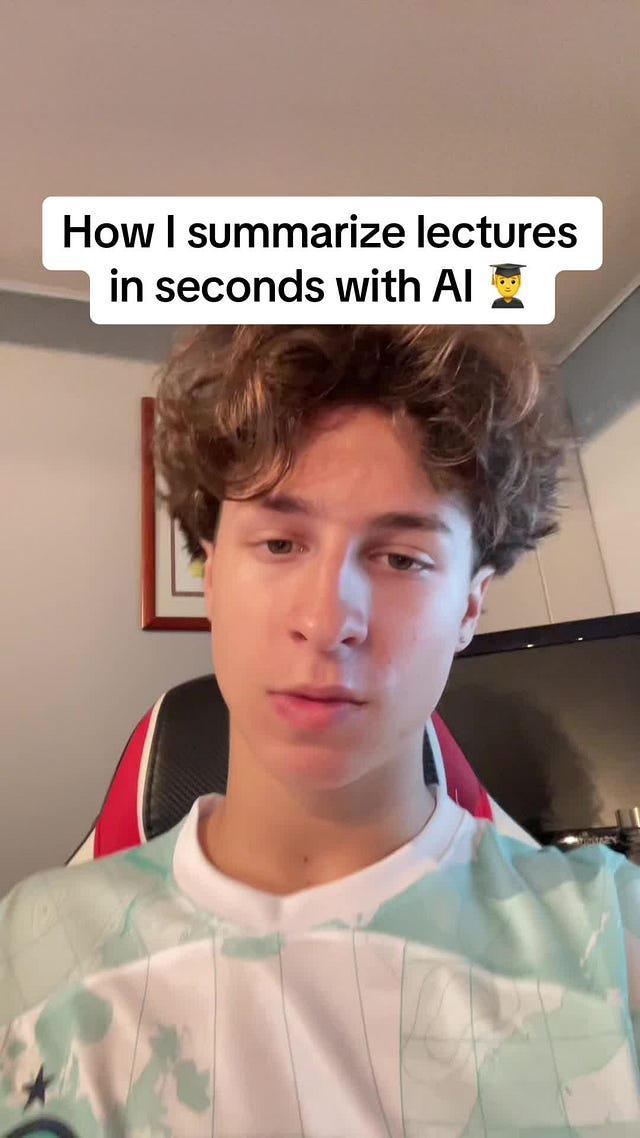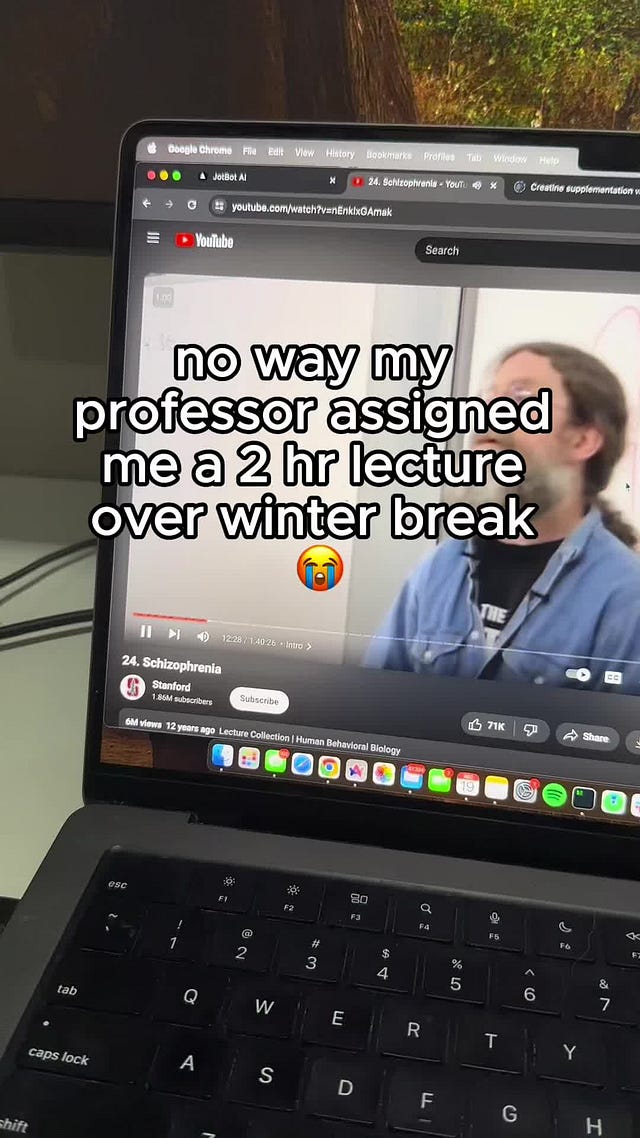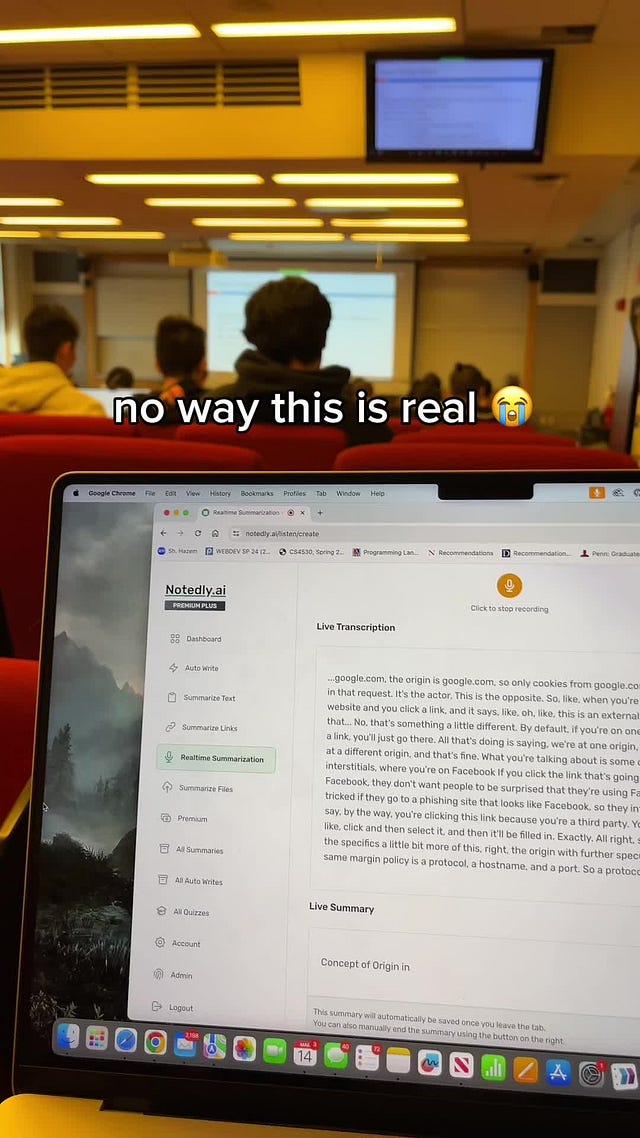AI's Promise To Pay Attention For You
This post is the second in the Beyond ChatGPT series about generative AI’s impact on learning. In the previous post, I discussed how generative AI has moved beyond text generation into skills like reading. In this post, I’ll cover how the technology is marketed to students in new ways, promising to use a machine to take notes for you, automating lectures and transcription, and even synthesizing the content for a user. The goal of this series is to explore AI beyond ChatGPT and consider how this emerging technology is transforming not simply writing, but many of the skills we associate with learning. Educators must shift our discourse away from ChatGPT’s disruption of assessments and being to grapple with what generative AI means for teaching and learning.
Beyond ChatGPT Series
Generative AI is about to disrupt lectures and note-taking in profound ways. There are dozens of apps that not only transcribe lectures into notes, but also ones that feed the transcript into a language model, automatically summarizing key points, synthesizing examples, and even creating personalized learning experiences to help students learn the material through flashcards and quizzes. (Note the language used in this ad is not safe for work).
Many educators are not aware of this specific use case for AI, or how developers are shaping the marketing behind it to students. AI’s impact on critical listening simply isn’t on most people’s radar, but it should be something we talk about when we talk about AI beyond ChatGPT.
Taking Notes As A Creative Act
Gay Talese chronicled some of pop culture's most influential minds over the past sixty years. His profiles of writers helped define a sort of literary journalism that is all but extinct now—hyper-personalized, in-depth, and revelatory. Talese’s method involved listening to all the noise and messiness of his interviewee’s life:
I learned [from my mother] ... to listen with patience and care, and never to interrupt even when people were having great difficulty in explaining themselves, for during such halting and imprecise moments ... people are very revealing—what they hesitate to talk about can tell much about them. Their pauses, their evasions, and their sudden shifts in subject matter are likely indicators of what embarrasses them, or irritates them, or what they regard as too private or imprudent to be disclosed to another person at that particular time.
There’s an art to note-taking, one Talese mastered. It is not easily taught because it is so deeply personal. Notes aren’t the same as a transcript—they aren’t meant to be a word-for-word mimetic example of a lecture or talk. When a writer jots down notes they aren’t simply taking down rote information, they’re processing the material, putting it in conversation with their thoughts. Notes are what a listener feels is most important and chooses to capture. They are judgments as much as words. This involves listening, being present, and making a whole slew of critical choices about what to include or exclude. It is a serious and playful expression of creative thought, mixing scribbling and doodling, with insight and critical reflection.
Talese’s notes on his profile of Frank Sinatra are creative chaos. Here, Talese doesn’t simply capture what his subject says or does or feels or thinks—he instead composes a snapshot portrait of the world they inhabit, shape, and tower above. Using GPT-4’s vision, I uploaded the notes and asked the AI to transcribe them. What it produced is pretty accurate at first glance, but what is missing are all of the human flourishes that make Talese’s notes meaningful and artistic.
Never Listen to Lecture Again
Talese’s account is a highly idealized vision of what note-taking can be as an art form. Many students likely don’t view their notes as anything more than a means to an end and toss them into the trash once they complete an assessment—a necessary exercise to complete a course with a decent grade.
Education hasn’t helped either. We’ve known for years that learning through lectures is often a poor substitute for active learning through small group activities, discussions, or other more innovative models of instruction. That lecture persists as the dominant form of instruction in many disciplines is in no small part economical. It’s far cheaper to teach a lecture hall filled with 120 or more students than to divide them up into smaller classes. Likewise, the physical classroom space on most campuses won’t accommodate the switch to smaller classes. Even the layout in many lecture halls, with rows of desks bolted to the floor and often chairs similarly fastened, prevents faculty from doing much more than standing in front of the class and giving a talk using some slides.
Many third-party app developers are building off of OpenAI’s API to create apps that promise an end-to-end user experience where a machine listens for you, complies with information, and then creates bespoke summaries all so you don’t feel burdened by listening or thinking about the content.
 Tiktok failed to load.
Tiktok failed to load.Enable 3rd party cookies or use another browser
Using AI Transcription Could Help So Many Students
Using generative AI to capture notes could be amazing for students who are neurodiverse, struggling with learning a second language, or who have physical disabilities that require technology to assist them in their learning. The help this could give students is undeniable. I’d love to use it at a conference to fully capture a talk, and then explore further using social annotation tools. Imagine that!
There are many examples of educators experimenting with AI transcription in positive ways using models like OpenAI’s Whisper, Otter.AI, and even the built-in automatic AI summary that’s now included in most enterprise versions of Zoom. Used intentionally to support instruction and learning, AI transcription could benefit students tremendously. Yet, for every utopian-styled use case we imagine for this technology and its impact on student learning, we must balance it with the ways these tools are increasingly marketed on social media to students not as a learning aid, but as another method to disengage and check out of the learning process.
Of Time Gained and Time Lost
It’s not just students who are embracing the allure of having an AI do the listening for you. Teachers are likewise turning to AI to do the listening for them and complete tasks they aren’t interested in.

 Tiktok failed to load.
Tiktok failed to load.Enable 3rd party cookies or use another browser
The problem with AI apps marketed to the public, and especially students, is that they equate learning with time-saving and little else. The same problem with AI transcription apps that allow a user to take notes for you is the same we see with AI reading assistants promising to summarize a text or a writing generator to write your essay for you. Such use cases promise to bypass learning content, simply providing the end user an aggregate summary, one that often flattens nuance, misses key points, or worse yet, radically alters a text’s meaning.
Wearable technologies like Limitless’s AI Pendant will soon be on the market, and with them comes another marketing pitch—let AI do all the listening for you everywhere. With a wearable AI device, any conversation can be recorded, summarized, and searched. We have no clue what this will do to student learning, privacy, or our sense of reality. I’m sure faculty aren’t going to be keen on having their conversations recorded, but it isn’t like there is an off-switch or policy that an institution can implement to curb misuse. If we want ethical AI usage, we’re going to have to teach it.
We Need More Intentional Engagement With AI
At the end of the day, we can't simply declare generative AI transcription and note-taking tools as good or bad for learning. Doing so rips away any nuance or agency in how students will use these tools. Like any transformative technology, when thoughtfully implemented as a learning aid, they could provide immense value in terms of accessibility. However, faculty are largely unaware of how students can use this technology. If students uncritically adopt AI transcription as a way to disengage and offload the critical thinking involved in actively listening, processing, and making sense of information, we're losing something crucial to learning.
Bans won’t work, nor will outright rejection of these tools. That would be turning a blind eye to their very real potential to help students who face barriers. The more productive path forward is to get intentional about using AI in ways that enhance education rather than replacing it. Doing that is going to take work. Far more so than simply asking a faculty member to change the way they teach, rather, we’re going to have to get foundational and start examining why we teach and why students are there to learn.
Note-taking shouldn’t become robotic transcription -- notes are an act of judgment, inquiry, and creative synthesis. Learning itself is about constructing knowledge, not merely consuming it. The risks of automating that away have unforeseen consequences that I cannot even begin to imagine. The incredible capabilities of generative AI should inspire us to reimagine learning experiences that blend the best of humans and machines.
Maybe automated transcripts will allow instructors to spend less time droning through content and more time facilitating discussions, creating hands-on activities, and personalized tutoring. Maybe students will use AI-generated notes as kindling to spark further questioning, research, and intellectual exploration of topics. Surely developers could design entirely new interfaces fueled by generative AI's capabilities to augment and not replace our creative impulses.
Sadly, that’s not where we are headed. Companies are selling technology as a truly destructive force for all manner of creative pursuits that make us human. Look no further than the recent Apple ad for their new iPad to see how Big Tech views human creativity—it flattens all of it.











I shared one of the above TikTok videos, the "how to summarize lectures in seconds" one, at a workshop at UVA today, and faculty here have been referencing it all afternoon. Thanks for taking one for the team, Marc, and going on TikTok to find these, so that I didn't have to! They're really helpful for getting inside at least some students' experiences.
I think the topic of note taking is really important in student learning. On the one hand, during the pandemic, videos of people actually creating works of art with their lecture notes or books proliferated, and I too witnessed this type of people creating masterpieces on their iPads or notebooks. On the other hand, as you have rightly highlighted, there are issues of student involvement whose critical issues, perhaps, are increasingly coming to the surface with the development of AI apps.